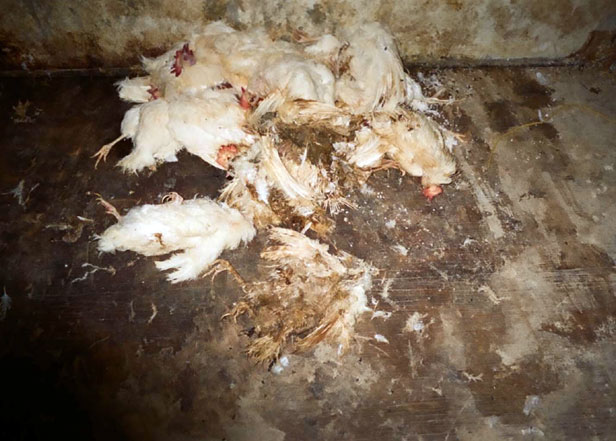 Photos taken by the FDA of the conditions at Wright County Egg, the source of half a billion recalled eggs that sickened thousands of Americans, show piles of decomposing chickens at the back of the hen houses. (Factory farms have a high rate of mortality.)
Photos taken by the FDA of the conditions at Wright County Egg, the source of half a billion recalled eggs that sickened thousands of Americans, show piles of decomposing chickens at the back of the hen houses. (Factory farms have a high rate of mortality.)
The following is a transcript of a discussion conducted by email during the past few days and lightly edited. (For the latest installment in this Food Fight series, see box, upper right; full bios are here.)
The first question we asked our participants to tackle was whether in fact the United States is in the midst of a “food-safety crisis.” (The answer: yes, no, and not the one we think we’re in.) Here’s the follow-up:
Will the Food Safety Modernization Act now before the Senate improve our protection from contaminated food, in particular, from the large-scale outbreaks of the type we’ve recently seen in eggs and peanut butter?
 Tom Philpott, Grist senior food writer: Well, obviously no single bill can address all the issues we’ve raised. I guess my answer is: Maybe. The best we can hope for from it is a step, probably a small one, in the right direction. It won’t affect the meat supply, for example, which is one of the prime sources of hazard in the food system.
Tom Philpott, Grist senior food writer: Well, obviously no single bill can address all the issues we’ve raised. I guess my answer is: Maybe. The best we can hope for from it is a step, probably a small one, in the right direction. It won’t affect the meat supply, for example, which is one of the prime sources of hazard in the food system.
Then there’s the fact that the bill has industry support. Call me perverse, but I am repelled by the fact that legislation needs the support of the industry it regulates if it has any hope of passing. I realize that’s the way things stand, but if the Grocery Manufacturers of America supports the bill, as it does, than I suspect that it is overly friendly to the huge players that need the most oversight. In her analysis of the bill on Grist, Food & Water Watch’s Elanor Starmer writes: “S. 510 requires the FDA to inspect high-risk food processors — think the Peanut Corporation of America — only once every five years, and low-risk processors every seven years. That wouldn’t have caught the salmonella that spread like … well, creamy peanut butter, out of PCA’s Georgia facility in 2006, 2007, and 2008.”
So in that regard, the bill seems a bit toothless. The bill would increases inspections — if still to a too-low level — and give the FDA authority to declare mandatory recalls, when now “the agency can only ask nicely,” as Elanor puts it. So, small step in the right direction.
 Michael Bulger, master’s candidate in food studies at New York University: It will improve our protection from large-scale outbreaks. We won’t be in the clear, but outbreaks will be prevented.
Michael Bulger, master’s candidate in food studies at New York University: It will improve our protection from large-scale outbreaks. We won’t be in the clear, but outbreaks will be prevented.
S. 510 says that facilities identified as high-risk would be required to be inspected more frequently than they are currently being inspected. I think we can agree on that. This will increase the chances that inspectors will catch a problem before it develops into something more serious. If a facility has a history of poor safety standards, that facility will be considered more risky and should be inspected more often.
Foreign inspections will also increase, with the goal being an annual increase in the number of foreign facilities inspected. Imported food will also be checked at the port of entry, with priority being given to companies and countries with poor compliance histories.
Under S. 510, in the event of an outbreak or identification of contaminated food, the FDA will have improved resources for communicating the danger to the public.
S. 510 will provide more inspectors, they will be better trained, and they will be doing more inspections. The laws of probability say that this will prevent outbreaks in the future.
 Judith McGeary, founder and executive director of the Farm and Ranch Freedom Alliance: I’ll echo Tom and say “maybe.” Moreover, unless the Tester amendment is adopted, the bill is likely to drive the small-scale local producers out of business, which would deprive consumers of the option to buy food that is not part of the flawed industrial food system. [Editor’s note: More on this topic later.]
Judith McGeary, founder and executive director of the Farm and Ranch Freedom Alliance: I’ll echo Tom and say “maybe.” Moreover, unless the Tester amendment is adopted, the bill is likely to drive the small-scale local producers out of business, which would deprive consumers of the option to buy food that is not part of the flawed industrial food system. [Editor’s note: More on this topic later.]
One would expect that increased inspections would improve the food safety system. But it’s not quite as simple as “more inspectors and more inspections mean safer food.” What will be inspected? How often? Will the inspectors be willing to crack down on big industry players or will they turn a blind eye to warning signs of problems?
S. 510 directs FDA to categorize facilities as “high risk” and allocate its resources for inspections based on a list of five factors and “any other criteria deemed necessary and appropriate.” After checking the various cross-references, the factors in classifying facilities as high risk are:
- The “risk of the food”
- The facility’s compliance history for food safety violations
- How good the facility’s HACCP paperwork is
- Whether the food is at high risk for intentional adulteration
- Whether imported food has gone through a qualification or certification program
The factors do NOT include:
- The size of the facility or the scope of distribution
- The level of commingling
- The degree of processing, length of transportation, duration of storage, etc.
- Environmental violations, such as those at the Wright County egg facilities
The effectiveness of the inspections will depend on whether FDA uses the catch-all “any other criteria” to truly identify high-risk facilities, namely the large-scale processors who commingle ingredients from a variety of producers and then transport them long distances to a wide range of consumers. Or will FDA continue its current track record of avoiding crackdowns on the big players, while wasting resources on inspections of the thousands of small-scale producers who do not actually pose a high risk of foodborne illness?
Unfortunately, since the bill does nothing to address the consolidation of the food supply in the hands of a few large entities, or the capture of the agency by those industry interests, the outlook is not encouraging.
More fundamentally, the bill fails to address the underlying causes of food-borne illnesses. As Mark Kastel has already pointed out in the last post, the CAFOs and E.coli 0157:H7 are the elephants in the room. I think that issue and many others stem from a fundamental lack of understanding of biological systems. Food has become viewed as an industrial commodity capable of being produced in factories, essentially no different from cars or stoves. When there is a problem in the production system, both the industry and the government look for a technical fix for that problem and ignore the underlying biological reason that the problem aro
se.
Related to that view of food is the view of food safety in which the regulators and industry seek to treat food as an artificial product rather than a biological one. They can mandate chlorine baths, irradiation, pasteurization, and other kill steps, but the reality is that food does not start out sterile and it can never end up sterile. The latest science supports the understanding that bacteria can play a significant role in supporting our immune system function and that the critical issues are in the interactions at the microbial level. But the food industry and the regulators continue to ignore the science in favor of the flawed technological model that that large-scale industrial food system is built upon.
 Ferd Hoefner, policy director for the National Sustainable Agriculture Coalition: I too am in the maybe camp. Some elements of the bill will clearly help, others might. But Judith has just done an excellent job laying out some of the fundamental false premises and left-out elements that will keep the bill from being a greater success.
Ferd Hoefner, policy director for the National Sustainable Agriculture Coalition: I too am in the maybe camp. Some elements of the bill will clearly help, others might. But Judith has just done an excellent job laying out some of the fundamental false premises and left-out elements that will keep the bill from being a greater success.
Those very substantial flaws notwithstanding, I hope Michael is right that some/many large-scale outbreaks will be prevented. But let me hasten to add that it is not actually true that under S. 510 FDA will have added resources for more inspectors and more inspections. One might think so listening to much of the debate, but this bill is an authorizing bill. The added resources will only come later, if at all, through appropriations bills in future Congresses.
In light of the current climate of fiscal restraint, this is no insignificant matter, and it puts a huge premium on making sure whatever current or extra future funding does come along gets spent on the most significant problems. We do not have time or space in this exchange to get into details, but suffice it to say it is very clear to me that trying to find funding for FDA to inspect the hundreds of thousands of farms that under current FDA regulations are considered food facilities would be misguided and in these budget times impossible in any event.
On the farm side, there are two ways out of this dilemma. One is contained in the manager’s amendment to the bill and would require FDA to rewrite (and hopefully narrow via risk analysis) those regulations. The other is to take whatever new money can be had and focus it on bigger bang for the buck activities including farmer training, education, and group certification.
Bulger: I think that everyone here agrees that some substantial changes need to take place within our food system to make it more safe. Still, if we all wait for the silver bullet to be delivered, I’m going to go from being the youngest member of the panel to being the oldest.
I feel that Jill Richardson did a good job of illustrating a key fracture in the debate over S. 510. In September, Jill wrote that where you stand on the bill boils down to how much you trust the government.
In the current political climate, you have ample company if you want to distrust government. It’s simple to cast the FDA as the lapdog of Big Ag. It makes it romantic to be an advocate of small, sustainable food, and it relieves the responsibility to try to work to change the current system. After all, it’s totally hopeless, isn’t it?
These sensational outbreaks and the loss in sales has the major food companies realizing it might be better to be regulated than to lose sales every time a competitor causes an outbreak. It’s time for the advocates to stand up and call their bet. The language in this bill is very clear in its intent to protect the viability of small businesses. If S. 510 can pass and make it to the rule-making period, I see a tremendous chance to engage the FDA and hold them to the intent of Congress.
I believe sustainable food advocates can make the most of this point in our history and set us on a path to a better system. Ten years ago, there wasn’t the movement that we see today. The momentum is real and the public is open to changing our food system.
 Patty Lovera, assistant director of Food & Water Watch: Sorry to be the last one to join in. Y’all have raised a lot of important points so far, and I just have a couple thoughts to add.
Patty Lovera, assistant director of Food & Water Watch: Sorry to be the last one to join in. Y’all have raised a lot of important points so far, and I just have a couple thoughts to add.
Food & Water Watch has been calling for a couple things that we think would make 510 more effective. The Tester amendment has already been mentioned here and we agree that it’s needed. [Editor’s note: Not quite — more later on this.] But we also think 510 could use some beefing up in one of its core functions — spelling out how often FDA inspects food-processing facilities (and we agree that there’s work to do in defining facilities). Right now, the bill calls for facilities to get inspected once every five years if they are classified as high risk, and once every seven years if they are classified as low risk. While this would be an improvement over what the agency averages now, it’s not a big enough change to fix what is one of the most frustrating things about FDA — they are set up to react to food safety problems, not prevent them.
That said, we get it that we need to make sure that what they think of as prevention doesn’t amount to technological fixes or crazy paperwork schemes dreamed up by consultants who get paid by the hour. Which is where the provisions in 510 that require consideration of impact on small-scale, organic, etc. and the Tester amendment come in and why they are so important. And it’s why the implementation phase of anything on food safety will be critical, so FDA gets the details right (including their definition of “risk”) and the programs are workable.
In these discussions, I always end up coming back to the bigger context of what is happening in food safety beyond this legislation. S. 510 has provisions requiring the agency to think about small-scale production, technical assistance, etc. The requirements that grocery stores put on farmers don’t. Nor does the “leafy greens” industry proposal to regulate itself through a marketing agreement. Nor the produce industry’s proposal for traceability.
Legislation may not make those things go away. But they exist because FDA is not getting the job done on food safety, which is why so many groups have been pushing so long for legislation.
 Russell Libby, executive director of the Maine Organic Farmers and Gardeners Association: S. 510 by itself isn’t going to do anything. It’s the combination of the legislation with the implementation that may make a difference. The food system is far too fragmented to actually think that just passing legislation will protect the public from contaminated food. We’ve had laws for decades that supposedly accomplish this.
Russell Libby, executive director of the Maine Organic Farmers and Gardeners Association: S. 510 by itself isn’t going to do anything. It’s the combination of the legislation with the implementation that may make a difference. The food system is far too fragmented to actually think that just passing legislation will protect the public from contaminated food. We’ve had laws for decades that supposedly accomplish this.
The bill gives FDA a few tools that will make it easier for them to enforce standards that are already in place. However, there is a presumption that more legislation, or more rules, or marketing orders, will make our food supply safer. And if safer food is the goal, there are as many solutions as there are problems. This is the challenge of the bill, and this approach. The food-safety training embedded in the bill may make more difference than anything else.
It will be years before the concepts in the bill are fully implemented. Me
anwhile, we all need to be thinking about what’s really going to produce safer food — more reliance on large and concentrated food processors and distributors who have full-time food safety compliance officers keeping up with the paperwork, or a widely dispersed network of farmers around the country, supplying their local and regional markets.
That’s the real conversation that S. 510 can’t, and won’t, address.
 Kathleen Chrismer, food-safety victims’ advocate: I agree with Michael, the issue of food-safety reform has been put aside for far too long.
Kathleen Chrismer, food-safety victims’ advocate: I agree with Michael, the issue of food-safety reform has been put aside for far too long.
There has never been a piece of legislation on any issue that has been perfect. You can’t make everyone happy, yet we all have the right to express our point of view, that’s the beauty of democracy. However, in terms of food safety, S. 510 is the closest we’ve gotten in over 20 years to acceptable food safety reform that will prevent contaminated food from entering the marketplace, instead of forcing producers and FDA to scramble to react in the aftermath of a major outbreak.
So far, nobody has addressed the issue of science-based testing and mandatory reporting of test results that show contamination. These key provisions are part of H.R. 2749, the House food-safety bill which passed in August 2009, and will provide for quicker identification of a potential problem before a product enters the food supply.
Additionally, should a contaminated product make its way into the marketplace, the testing and reporting measures will aid FDA in pinpointing the source of the problem, essentially saving producers from having to destroy their similar product or suffer losses due to consumer fear. Hopefully, once S. 510 passes in the Senate, these provisions will be incorporated into a final bill in Conference.
There has been a lot of discussion and focus on farmers, eggs, and produce, but we need to remember that those are not the only products that fall under FDA authority. Spices, canned goods, frozen foods, etc. fall under the FDA umbrella as well. The tea you drank this morning or the garden-burger you had for lunch, really anything you find on your grocer’s shelf, is a product that has been through some type of production or packaging process and is therefore a potential candidate for contamination.
As much as we would all like to only eat locally grown foods from farmers we know and trust and limit our consumption of processed foods, the reality is that in today’s society it’s not always possible. There are not enough small-scale farmers to feed the 310 million people in the United States. I live in an area with limited access to truly “local” produce, the farmer’s market three blocks from my home has vegetables that have traveled all the way from Stockton, Calif. While I enjoy the products they sell, I don’t consider the vendor part of my community.
This bill is not about the big bad government taking over or squeezing out the local farmer, it’s about preventing the 5,000 deaths that occur each year as a result of the unknowing consumption of food-borne pathogens.
Bulger: I agree with Kathleen that this is an essential part of the legislation. The Senate bill asks facilities to develop hazard analysis and risk-based control plans (HARCP). [Such plans are also called HACCP, for Hazard Analysis & Critical Control Points.] Basically this consists of identifying points in the processing system (refrigerated holding, employee handling) that could be potentially dangerous, and then developing controls that can be implemented at those points (checking temperatures daily, washing hands).
The small facilities have longer to comply and the FDA has the power to exempt small facilities from this HARCP plan if they are deemed a low-risk operation. For those that do fall under the new regulations, S. 510 says that FDA must “provide sufficient flexibility to be practicable for all sizes and types of facilities, including small businesses such as a small food-processing facility co-located on a farm.”
Many larger operations already test for microbial pathogens. As of today, they are only required to disclose limited information about test results to inspectors. If they test positive for a pathogen, they can quietly attempt to clean up and if the FDA asks for test results the company can claim they are private. This happens more often then we would hope and it contributes to the feeling that FDA is turning a blind eye to large processors, when much of the time the FDA is being kept in the dark.
Under the Senate’s version of the Food Safety Modernization Act, the companies will no longer be able to claim proprietary rights to their test results when the FDA comes knocking. Section 418(h) of the bill states the last two years of test results have to be made available to the FDA whenever a request is made by an official.
Libby: Obviously, if all the provisions of S. 510 are implemented, there will be improved protection. Who will be producing food under the standards is another question.
The assumption that the 210,000 produce farmers in the country are all going to be putting together HAACP plans is troublesome. It’s compounded by including all the farmers who supply all the food exporters who ship to this country. Is this what will make our food supply safer? A HACCP plan, or GAP certification, may be parts of the solution, but they are not the entire answer.
The carve-outs for flexibility in S. 510 are the result of over a year of work from the National Sustainable Agriculture Coalition and others. Many of them were initially opposed by the consumer groups, but are critical to having a bill that doesn’t make the problem worse rather than better, at least in terms of the impact on the farm side.
Farmers, at least the small family farms who produce the food that you buy at farmers’ markets or in a CSA, don’t see themselves as food processors. Yet under the Food Bioterrorism Act of 2002, and FDA’s interpretation of that law through regulations, washing, and packing the produce and sending it to a wholesale market can turn the farm into a regulated processor.
Is FDA going to have the resources to visit all of these farms, even on a five-year cycle? No. Then why write legislation that’s too inclusive instead of clarifying the areas where FDA does need both authority and focus? That’s where much of the conflict about this bill arises.
 Jean Halloran, director of food policy initiatives at Consumer Union (publisher of Consumer Reports): The question posed wasn’t whether this bill will solve all our food-safety problems, or if it is the best possible food safety bill — it certainly isn’t everything that consumer groups wanted. But the question is whether it will improve safety, particularly with regard to preventing major serious outbreaks like we’ve seen in peanut butter. I think the answer is absolutely yes — just requiring food processors to register that they exist is a major improvement. FDA didn’t even know that Peanut Corp was making peanut butter, and would likely have visited it sooner, following the Conagra outbreak, if it did.
Jean Halloran, director of food policy initiatives at Consumer Union (publisher of Consumer Reports): The question posed wasn’t whether this bill will solve all our food-safety problems, or if it is the best possible food safety bill — it certainly isn’t everything that consumer groups wanted. But the question is whether it will improve safety, particularly with regard to preventing major serious outbreaks like we’ve seen in peanut butter. I think the answer is absolutely yes — just requiring food processors to register that they exist is a major improvement. FDA didn’t even know that Peanut Corp was making peanut butter, and would likely have visited it sooner, following the Conagra outbreak, if it did.
Giving FDA mandatory recall authority so they don’t have to wheedle and cajole companies into cooperating is also a significant major step.
Libby: Here’s where one of my fundamental concerns still lies, and I’ll a
ddress it more in the third question. The definition of facility embedded in the rules for the Food Bioterrorism Act of 2002, and relied upon in S. 510, makes many farms into facilities. Any transformation of product does it — and then you jump back out of being a facility by selling at least 50.1% of your product directly to individual consumers.
Unless, of course, you produce a product of concern — sprouts, juice and juice products, or, as seems likely, leafy greens, tomatoes, and melons — and then maybe you’re back in for that part of your farm, and potentially out for the rest. Most of the 210,000 produce farmers in the U.S. (2007 Census) grow at least one of those three vegetable crops, particularly if they are selling directly to consumers. Are they facilities, or are they not?
 Bonnie Azab Powell, Grist food editor and Food Fight moderator: Let’s stop here, as that sets us up for our next questions, about (3) whether S. 510 unfairly burdens small and medium-size farmers and producers (and whether the Tester amendment mitigates that sufficiently), and (4) whether it gives the FDA too much power — or not enough.
Bonnie Azab Powell, Grist food editor and Food Fight moderator: Let’s stop here, as that sets us up for our next questions, about (3) whether S. 510 unfairly burdens small and medium-size farmers and producers (and whether the Tester amendment mitigates that sufficiently), and (4) whether it gives the FDA too much power — or not enough.



